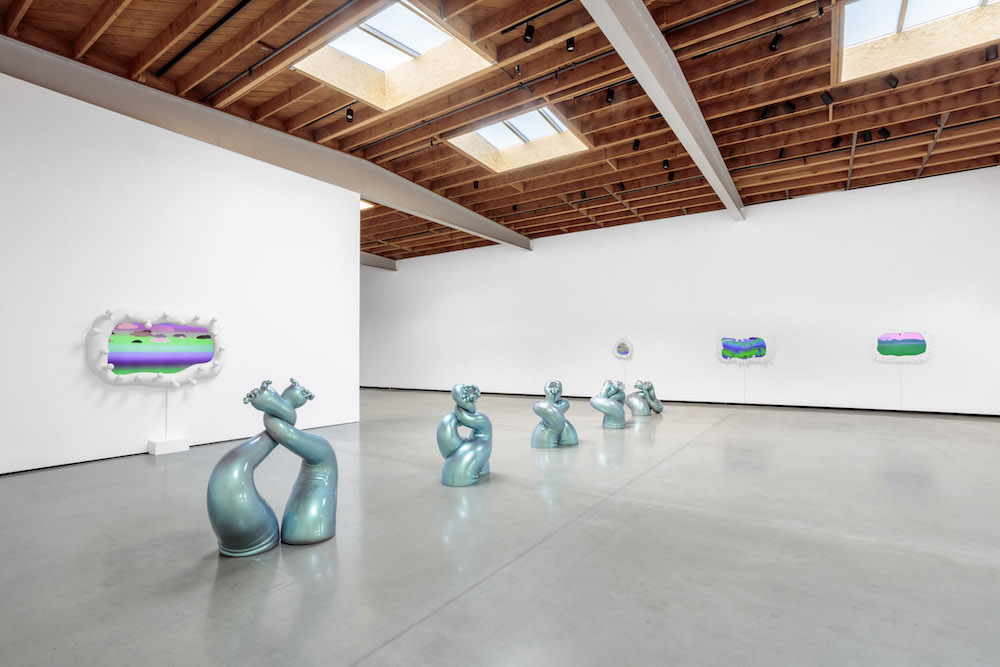For your next fancy art after-party, I would recommend the following signature cocktail. While somewhat nontraditional and off-menu, this enchanted concoction is guaranteed to please and is crafted with a simple combination of ingredients: two parts childhood nostalgia, one part digital manipulation, one part confusion, a splash of Dr. Seuss and a hefty pinch of Wonka (Wilder vintage). Chill and mix vigorously in a furry tumbler. Pour into a bulbous gold glass with stubby legs. Feel free to salt the rim with additional form or function to your liking. Serve as a double and this would be the distinct aperitif à la the Haas Brothers.
The duo, Nikolai and Simon Haas, have been rising stars within the art and design world for some time. As in many epic Greek poems, the heroes have an uncompromising vision which does not formally align with previously established norms. Many interviews with the Haas brothers have focused on the aspect of art vs. design within their work, but it is clear through our conversations that neither world is their driving force—nor dominates artistic decisions. The Haas brothers unapologetically make objects that speak to a vision distinctly their own, refusing to be defined or influenced by simple function or lack thereof. Change the name on the title card and perception of the object transitions from a sculpture to eclectic home décor.
My focus was to explore the brothers’ thoughts regarding co-creation, nonconformity, and most of all the integration of technology into their work—both archaic and cutting edge. This twin team is clearly at the forefront of bespoke high-end digitally manipulated objects, and luckily enough it just so happens that they recently finished a show at Jeffrey Deitch in LA that they consider their “deepest dive into technology yet.”

Haas Brothers, “Sunset People” (exhibition, installation view), 2023. Photo: Joshua White.
The worry is that many creatives use technology somewhat as a crutch these days. Whether providing the ability to enlarge small maquettes to monumental proportion or create hyper-detailed miniatures in the computer, it becomes a slippery slope where technology can easily overtake the entire artistic process. In conversation, this potential pitfall is acknowledged, but also casually discarded. Nikolai—the more physically hands-on/sculpturally oriented of the pair—explained, “We aren’t a practice in specific technology, we use it to express. They are simply just additional tools.” His brother Simon’s bond to technology clearly differs—he is the “coder” of the two and recounted the moment during the pandemic in which he began working in the 3D program Blender—and it all changed. The technology he had envisioned for years had finally caught up. The floodgates were now open to new ways of creating within even the most classic materials in their repertoire, bronze and marble. Same style, just new tools.
In their exhibition “Haas Brothers: Sunshine People,” these new tools are no more apparent than in the “Emergent Sculptures” series, which consists of five life-size sculptures, each showing two biomorphic worms with phalange faces locked in a disintegrating embrace. Created by Simon in Blender, these 3D works have run through a physics simulation. Is that simulation a beautiful waltz, a heated argument or a loving goodbye embrace? Nikolai summed it up best, “The shapes are emergent. We didn’t decide the orientation, we ran them into each other and chose moments that we thought felt poetic—that was our filter on it. The viewer applies their own version of what they think the sculpture is emoting. These are emotional values that a simulation is absolutely not capable of, but humans just can’t help themselves but to apply their vision of it onto the artwork. To us this is what the show is about. It is this human projection of self onto work.” For me, I saw two lovers holding on until the last dying moment.



















0 Comments